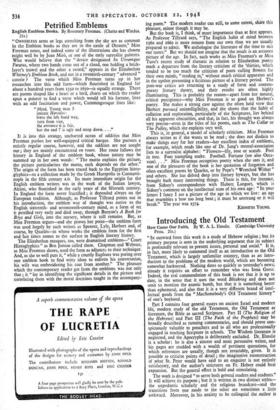Petrified Emblems
" OWNERLESS arms or legs stretching from the sky are as common in the Emblem books as they are in the castle of Otranto," Miss Freeman notes, and indeed some of the illustrations she has chosen might well be by Joan Miro, or one of the early surrealist painters. Who would believe that the " device designated In Utrumque Paratus, where two hands come out of a cloud, one holding a brick- layer's trowel and the other a sword," appears in the Elizabethan Whitney's Emblem Book, and not in a twentieth-century " advanced " coterie ? The verse which Miss Freeman turns up in her researches into this odd form—which flourished in England for about a hundred years from 155o to 1650—is equally strange. There are poems shaped like a heart or a bird, charts on which the reader spun a pointer to find a verse which would tell his fortune, lines with an odd fascination and power, Cummingsesque lines like: " Mind, Young man 5
imitate Hercules:
leave the left hand way,
turn from vice,
the entrance 6 is fair.
but the end 7 is ugly and steep down.. . ."
It is into this strange, uncharted ocean of oddities that Miss Freeman pushes her well-equipped critical barque. She pursues a strictly regular course, however, and the oddities are not sought out ; they are mainly encountered en route. Her route follows the history in England of the emblem book, whose nature may be summed up in her own words : "The motto explains the picture, the picture particularises the motto, each depends on the other." The origin of the form has been traced back to the Egyptian hiero- glyphics—to a collection made by the Greek Horapollo in Constanti- nople in the fifth century A.D. Its more immediate origin for the English emblem writers was in the work of the Italian lawyer, Alciati, who flourished in the early years of the fifteenth century. In England the form never fructified ; it depended always on the European tradition. Although, as Professor Tillyard points out in his introduction, the emblem way of thought was native to the English sixteenth- and seventeenth-century mind, as a form of art it petrified very early and died away, through Bunyan's A Book for Boys and Girls, into the nursery, where it still remains. But, as Miss Freeman argues—and she proves her point—the emblem form was used largely by such writers as Spenser, Lyly, Herbert and, of course, by Quarks—in whose works the emblem form for the first and last times comes to the surface in English literary history.
The Elizabethan masques, too, were dramatised emblems—" Court Hieroglyphics " as Ben Jonson called them. Chapman and Webster, as Miss Freeman shows, used the form as adjuncts to their technique. And, as she so well puts it, " while a courtly Euphues was poring over one emblem book to find witty ideas to enliven his conversation, his wife was embroidering his coat from another." The pleasure which the contemporary reader got from the emblems was not only that ; it " lay in identifying the significant details in the picture and correlating them with the moral doctrines taught in the accompany- ing poem." The modern reader can still, to some extent, share this pleasure, minor though it may be.
But the book is, I think, of more importance than at first appears. As Professor Tillyard says, "The English habit of mind between 156o and 166o is more remote from our own than we are usually prepared to admit. We anthologise the literature of the time to suit our tastes." But we should not imagine that the result is an accurate picture of the age. In fact, such works as Miss Freeman's or Miss Tuve's recent study of rhetoric in relation to Elizabethan poetry mark a departure from the literary criticism of the 'thirties, which tended to be too much the criticism of poets culling flowers for their own minds, "reading in," without much critical apparatus and in the upshot presenting a fictitious picture of a literary period. The post-war critics are returning to a study of form and contem- porary literary theory, and their results are often highly illuminating. This is probably the reason—apart from her natural, critical percipience—why Miss Freeman is so good on Herbert's poetry. She makes a strong case against the often held view that Herbert pursued unintelligibility, and she shows that the habit of collation and exploration, particularly of the Scriptures, lies behind all his apparent obscurities, and that, in fact, his thought was always very precise—even in the tides of his poems, such as The Collar or The Pulley, which she explains very well.
This is, in general, a model of scholarly criticism.. Miss. Freeman always writes as if she wants to be read ; she does not disdain to make things easy for her readers—her excellent index of emblems, for example, which reads like one of Dr. Jung's mental-association lists to a surrealist alphabet: "Flowers—lily, rose or scarab. Fool in tree. Foot trampli z snake. Football. Fortune (see also Occa- sion). . . ." Miss Freeman recognises poetry when she sees it, and one of the pleasures of the book is her quotation of forgotten and often excellent poems by Quarles, or by Pope's " Wretched Wither" and others. She has delved deep into literary byways, but she has brought back many interesting things. There is this, for instance, from Sidney's correspondence with Hubert Languet, which is Sidney's comment on the intellectual state of his own age : " In your letters I fancy I see a picture of the age in which we live: an age that resembles a bow too long bent ; it must be unstrung or it will break." The year was 1574.
KENNETH YOUNG.


































 Previous page
Previous page